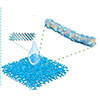| Mar 07, 2022 |
|
(Nanowerk News) The rapid development of ultra-thin electronic skins (e-skins) – also called epidermal electronics or electronic tattoos – is opening new realms of possibility for flexible and stretchable monitoring gadgets that are wearable directly on the skin. These e-skin devices can be used for, among other things, prosthetics and rehabilitation, optogenetics, human-machine interfaces, human-computer interaction in gaming, and as diagnostic tools in the medical field (read more on this topic in “Lab-on-skin: Nanotechnology electronics for wearable health monitoring“).
|
|
E-skins require equally thin and flexible pressure sensors with a large response range and high sensitivity. The pressure-sensitive performance of devices can usually be evaluated via several basic characteristics, in terms of durability/stability, response/recovery rate, detection range, and sensitive response, which also provide a reference for the functional design of the sensor. Among these characteristics, detection range and sensitive response are two key factors affecting sensor property.
|
|
Researchers now report an MXene-based approach to designing the sensing material of e-skins to meet the above two needs.
|
|
As they report in ACS Applied Materials & Interfaces (“MXene/ZIF-67/polyacrylonitrile (PAN) Nanofiber Film for Ultra-sensitive Pressure Sensors”), they fabricated a flexible pressure sensor by sandwiching a conductive MXene/ZIF-67/PAN film between PDMS and copper electrodes.
|
|
Benefiting from the special rough and porous structure and 3D stable conductive network of the nanofiber film, the researchers’ sensor is able to simultaneously obtain a wide sensing range (0−100 kPa) and high sensitivity (62.8 kPa−1) and display a robust mechanical stability (over 10,000 cycles), and fast response/recovery time (10/8 ms).
|
 |
| MXene/ZIF-67/PAN preparation and device structure. (a) Schematic illustration of the MXene/ZIF-67/PAN nanofibers. (b) Working mechanism of MXene/ZIF-67/PAN film-based pressure sensor. (Reprinted with permission by American Chemical Society)
|
|
As illustrated above, to fabricate their e-skin sensor, the team first obtained flexible nanofiber films with rough structures via in situ embedding of metal-organic framework (MOF) particles on flexible PAN nanofibers.
|
|
Incorporating MXene nanosheets into these films resulted in a three-dimensional (3D) conductive network structure. As the authors point out, the unique rough structure of this MXene/ZIF-67/PAN film allows for better connection of the conductive pathways when force is applied, which contributes to the ultrahigh sensitive response and broad sensing range of the assembled flexible device.
|
|
The authors conclude their report by noting that the excellent sensing properties, coupled with encouraging benefits such as good biocompatibility and high flexibility, makes this sensor a competitive candidate for flexible and wearable health devices.
|


